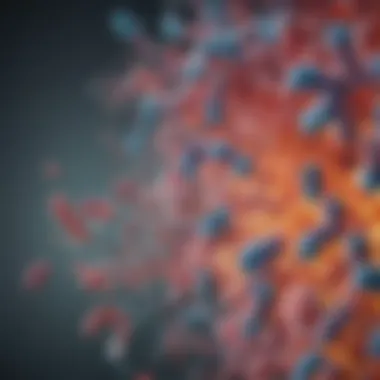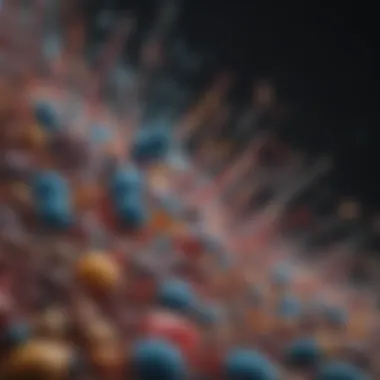Gut Antibiotics: Impacts on Health and Immunity


Intro
The relationship between gut microbiota and antibiotics has drawn significant interest from researchers and healthcare professionals alike. As antibiotics have become widespread in medical use, their impact on human health has evolved into a topic of substantial importance. This section explores the implications of gut antibiotics and clarifies the mechanisms involved in altering microbial communities in the gastrointestinal tract.
Understanding gut antibiotics can unveil the potential health benefits and risks associated with their usage. The exploration of this subject is particularly relevant as the prevalence of antibiotic resistance rises globally. Insights from this discourse can lead to optimized therapies that maintain gut health while addressing infectious diseases.
Research Overview
In the field of gut microbiota research, a thorough understanding of the interplay between antibiotics and microbial populations is fundamental. Various methodological approaches have emerged to unravel these complex dynamics.
Methodological Approaches
Research often employs a combination of in vitro studies, meta-genomic analyses, and clinical trials to analyze the effects of antibiotic interventions on gut microbiota. Techniques such as 16S ribosomal RNA sequencing enable scientists to identify and quantify the diversity of microbial species in a given sample. This is crucial in assessing how different antibiotics impact specific microbial populations.
Moreover, experiments involving animal models facilitate the observation of physiological and immunological changes following antibiotic treatment. These methodological strategies support the investigation of both short-term and long-term consequences of antibiotic use on gut health.
Significance and Implications
The implications of understanding gut antibiotics extend beyond academic inquiry into practical applications. An integral aspect is the significance of maintaining a balanced microbiome. Disruptions to microbial communities can lead to various health issues, including inflammatory bowel disease, obesity, and metabolic disorders.
Furthermore, as antibiotic resistance becomes increasingly concerning, the necessity for targeted antibiotic therapies emerges as a critical focus. By understanding the mechanisms that govern microbial shifts, researchers aim to design treatment strategies that minimize collateral damage to beneficial gut bacteria.
"The potential of targeted antibiotic therapies lies in their ability to selectively eliminate pathogens while sparing essential members of the gut microbiome."
Current Trends in Science
Innovative scientific techniques are continually evolving to address the challenges posed by gut antibiotics. Researchers are integrating novel methodologies to study microbiota and antibiotic interactions more effectively.
Innovative Techniques and Tools
The advancement of high-throughput sequencing technologies allows for detailed profiling of gut microbiota and identification of specific shifts caused by antibiotic treatment. Metabolomics and proteomics are also becoming valuable tools in this domain as they help in understanding the functional alterations within microbial communities.
Interdisciplinary Connections
The field draws connections across multiple disciplines, encompassing microbiology, immunology, and pharmacology. New insights into how microbial metabolites influence host immune responses highlight the need for collaborative efforts in research. These interdisciplinary interactions contribute to a holistic understanding of gut health and antibiotic use, paving the route for future innovations.
Research in gut antibiotics remains a vital area with promising prospects that can redefine therapeutic strategies and improve overall health outcomes.
Prelims to Gut Antibiotics
The discussion of gut antibiotics is increasingly relevant in today's scientific landscape. This focus arises not only from the rise in antibiotic prescriptions but also from the consequential effects on the gut microbiome. Gut antibiotics hold valuable implications for our health, influencing everything from digestion to immune system functionality.
Understanding gut antibiotics is vital for both practitioners and researchers. Their role in managing infections or conditions involving harmful bacteria shows the balance they strike between benefits and potential harm.
When we examine gut antibiotics, we see two significant aspects. First, we explore why they are administered, often in response to bacterial infections. Second, we must consider the consequences of their use, which includes disruption of the gut microbiome, impairment of digestion, and potential long-term health issues.
Overall, our investigation into gut antibiotics will delve into how these agents function, their historical context, and their overall implications on health and disease. This exploration will highlight the need for a nuanced understanding of gut health amidst the prevailing use of antibiotics.
Definition and Scope
Gut antibiotics refer to a class of antimicrobial drugs that target bacteria residing in the gastrointestinal tract. These drugs can be broad-spectrum, affecting a wide range of bacterial species, or narrow-spectrum, aimed at specific pathogens. Their primary function is to eliminate pathogenic bacteria, which can cause infections or inflammation. However, they often do not discriminate between beneficial and harmful bacteria, leading to complex challenges.
The scope of gut antibiotics extends beyond simple pathogen elimination. Current research investigates potential therapeutic uses in conditions like inflammatory bowel diseases and certain metabolic disorders. The intricate interplay between antibiotics and the gut microbiota forms a substantial component of modern medical studies.
Historical Context of Antibiotic Use
The history of antibiotics dates back to the discovery of penicillin by Alexander Fleming in 1928. This groundbreaking moment marked the beginning of an era where bacterial infections could be treated effectively. Initially, antibiotics were viewed as revolutionary, reducing mortality rates and expanding medical capabilities considerably.


Over the decades, the scope of antibiotic treatment expanded significantly. However, the rise of antibiotic resistance emerged as a critical concern. With overuse and misuse of antibiotics, many pathogens have adapted and become resistant to treatment. This challenge stresses the need for targeted approaches and careful management of antibiotic therapies, particularly concerning gut health.
In summary, the exploration of gut antibiotics calls for a careful evaluation of their necessity against their potential drawbacks. As we progress through this article, we will further discuss mechanisms, implications, and future directions for research in this vital area.
The Human Gut Microbiome
The human gut microbiome plays a crucial role in maintaining health and well-being. It is a complex ecosystem comprised of trillions of microorganisms, including bacteria, viruses, fungi, and archaea. This extensive community performs a variety of essential functions, many of which are not yet fully understood. The balance and composition of these microbial populations can significantly affect an individual’s health, particularly in the context of antibiotic use. Understanding the gut microbiome is vital to explore how antibiotics alter these communities and lead to both positive and negative health outcomes.
Composition of the Microbiome
The human gut microbiome is incredibly diverse. It consists primarily of bacterial species, with over 1,000 different types identified. Key phyla such as Firmicutes, Bacteroidetes, and Actinobacteria dominate the gut environment. These communities are unique, varying significantly from person to person, influenced by factors like diet, environment, and age.
Research has shown that the composition of the microbiome directly influences metabolic processes, immune responses, and even mental health. A diverse microbiome typically correlates with better health, while decreased diversity can indicate dysbiosis, a condition often linked to various health issues such as obesity, diabetes, and inflammatory bowel diseases.
Functions and Benefits
The gut microbiome serves multiple functions that are vital for health. Some key roles include:
- Digestion and Metabolism: Gut bacteria assist in breaking down complex carbohydrates and synthesizing essential vitamins such as vitamin K and some B vitamins.
- Immune System Regulation: A healthy microbiome educates and modulates the immune system, helping to distinguish between pathogens and non-harmful agents.
- Protection Against Pathogens: The microbiome acts as a barrier, outcompeting harmful microbes for resources and preventing infections.
- Production of Short-Chain Fatty Acids: Beneficial bacteria ferment dietary fibers, producing short-chain fatty acids that can have anti-inflammatory effects and improve gut health.
"Balance in the gut microbiome is crucial for overall health, influencing everything from metabolic function to disease susceptibility."
In summary, the gut microbiome is not merely a collection of microbes but a dynamic entity that significantly impacts health. Its composition and function can be affected by various factors, most notably antibiotic use. A thorough understanding of these elements is essential for grasping the larger implications of gut antibiotics on human health.
Mechanisms of Action for Gut Antibiotics
Understanding the mechanisms of action for gut antibiotics is vital for comprehending their role in modifying gut microbiota. This section addresses how these antibiotics function, highlighting the differences between them and providing insight into their effects on gut health. Knowing how these medications work can guide more informed choices in their usage and highlights the need for future research.
Broad-Spectrum vs. Narrow-Spectrum Antibiotics
Broad-spectrum antibiotics are compounds that can target a wide range of bacteria. They can be useful when the specific causative agent of an infection is unknown. Some of the common broad-spectrum antibiotics include amoxicillin and tetracycline. These antibiotics can disrupt many types of bacteria in the gut, both harmful and beneficial.
In contrast, narrow-spectrum antibiotics focus on specific bacteria. For instance, vancomycin is often used to treat infections caused primarily by gram-positive bacteria. The limitation of broad-spectrum antibiotics lies in their potential to disturb the balance of the gut microbiota.
Here are some aspects to consider:
- Broad-spectrum antibiotics can lead to overgrowth of resistant strains.
- Narrow-spectrum options can preserve beneficial bacteria, potentially promoting a healthier microbiome.
"The choice between broad and narrow-spectrum antibiotics can significantly impact gut health, influencing outcomes of treatment and recovery."
Impact on Microbial Community Structure
The utilization of gut antibiotics can result in notable changes to the microbial community structure. Antibiotics selectively kill sensitive bacteria, leading to shifts that can favor resistant strains. This imbalance can impact overall health.
A disrupted microbiome may lead to:
- Reduced diversity of microbial populations.
- Overgrowth of pathogenic bacteria such as Clostridium difficile, which can cause severe infections.
The consequences of such disruption are profound. Reduced microbiome diversity can affect metabolic processes, immunity, and even mood. Restoring balance becomes difficult as some species decline significantly or are eradicated. Understanding these dynamics is essential for developing targeted interventions later.
Short-Term Effects on Gut Health
The short-term impacts of gut antibiotics on health can manifest quickly. Patients often report changes in digestion, appetite, and energy levels. Common short-term effects include:
- Diarrhea as a side effect of altered gut flora.
- Nausea and vomiting due to changes in microbial metabolism.
- Potential allergic reactions to antibiotics, impacting overall well-being.
These effects can be concerning, especially in vulnerable populations like children and the elderly. The implications require, therefore, careful monitoring and management.
Long-Term Implications of Antibiotic Use


The long-term implications of antibiotic use are critical to understanding how these treatments affect human health over extended periods. While antibiotics serve a vital role in treating infections, their impact on the gut microbiome can lead to important and sometimes adverse outcomes. This section will delve into two major areas: the development of antibiotic resistance and chronic health conditions associated with antibiotic use.
Development of Antibiotic Resistance
Antibiotic resistance is a growing concern in modern medicine. When antibiotics are used, they kill or inhibit the growth of susceptible bacteria. However, not all bacteria are equally affected. Some survive and potentially acquire resistance genes. Over time, these resistant bacteria can proliferate, leading to infections that are more difficult to treat. The World Health Organization (WHO) reports that antibiotic resistance may lead to 10 million deaths per year by 2050 if current trends continue.
Key factors contributing to the development of antibiotic resistance include:
- Inappropriate prescribing practices: Over-prescription or misuse of antibiotics can accelerate resistance.
- Incomplete courses of treatment: Not finishing antibiotic regimens can leave surviving bacteria with the opportunity to develop resistance.
- Environmental factors: Antibiotics can enter the environment, encouraging resistance in non-target bacteria.
Efforts to combat resistance include promoting responsible antibiotic use and developing new antibiotics or alternative therapies. A coordinated approach is essential to manage this pressing health issue.
"Antibiotic resistance is a global crisis that threatens the ability to treat common infectious diseases.” - World Health Organization
Chronic Health Conditions Linked to Antibiotic Use
The long-term use of antibiotics has been associated with various chronic health conditions. Research has indicated that alterations to the gut microbiome can have far-reaching consequences beyond immediate digestive issues.
Several chronic conditions linked to antibiotic use include:
- Inflammatory Bowel Disease (IBD): Disruption of gut microbiota from antibiotics may trigger or exacerbate conditions like Crohn's disease and ulcerative colitis.
- Obesity: Studies suggest that antibiotic exposure in early life is linked to a higher risk of obesity in children, potentially due to alterations in the gut microbiome that affect metabolism.
- Autoimmune diseases: There's emerging evidence suggesting a potential connection between antibiotic use and the development of autoimmune diseases, possibly through microbiome imbalances.
Understanding these associations is crucial for guiding future antibiotic policies and patient care. Insights from ongoing research are important for modifying treatment approaches to mitigate these risks.
In summary, the long-term implications of antibiotic use extend beyond immediate therapeutic benefits. Awareness and continued research are necessary to address concerns around antibiotic resistance and chronic health conditions. The balance between utilizing these drugs effectively and preserving gut health is vital for fostering overall well-being.
Research on Targeted Antibiotic Therapies
The study of targeted antibiotic therapies is a growing area of importance within the realm of gut health and microbiome management. Unlike traditional antibiotics that indiscriminately kill a broad range of bacteria, targeted therapies focus on specific pathogens or microbial groups. This precision is crucial, as it helps preserve beneficial microbes while effectively combating harmful ones. The potential benefits of such therapies are significantly high, especially in treating conditions linked to dysbiosis, where there is an imbalance of gut bacteria.
When considering the implications of these targeted approaches, one must think about the relationship between gut health and overall well-being. A tailored antibiotic strategy can minimize the disruption to the gut microbiome, reducing the odds of adverse effects like antibiotic resistance and gastrointestinal disturbances. Researchers are exploring how such strategies can change the way we treat infections, with potential applications in chronic conditions tied to microbiome imbalances.
Key elements in this research include:
- Identification of specific pathogens: Genetic and biochemical profiling helps identify the exact bacteria responsible for an infection. This allows for the development of antibiotics that specifically target these pathogens.
- Mitigation of side effects: By focusing on specific pathogens rather than using broad-spectrum antibiotics, patients are less likely to experience the complications associated with broader antibiotic treatments.
- Restoration of gut health: Following targeted treatments, strategies can be implemented to restore and support the microbiome, helping to prevent further issues related to gut health.
"The focus on targeted antibiotics represents a paradigm shift in how we approach infections, with the potential to safeguard the gut microbiota."
The rise of precision medicine and novel interventions play a crucial role in advancing this field.
The Rise of Precision Medicine
Precision medicine is increasingly recognized as an essential facet of modern healthcare. The concept revolves around tailoring medical treatment to the individual characteristics, needs, and preferences of patients, often using genetic information. In the context of gut antibiotics, precision medicine promises a transformative approach to treatment.
By utilizing advanced diagnostic tools, researchers can pinpoint specific gut bacteria associations with diseases. For instance, understanding the genetic profiles of gut microbes helps in developing antibiotics that can specifically act on undesired bacterial populations. This targeted strategy minimizes collateral damage to beneficial microbiota.
The implications are significant:
- Personalized treatment plans: Therapies could be customized to address unique microbiome compositions, resulting in more effective treatment regimens.
- Enhanced patient outcomes: Focusing on individual characteristics optimizes recovery and has the potential to decrease the incidence of recurrent infections.
Novel Approaches to Treating Gut Dysbiosis
Gut dysbiosis has been linked to various health issues, including obesity, diabetes, and autoimmune disorders. Traditional antibiotic use in these scenarios often leads to detrimental long-term effects. Therefore, novel treatment strategies are essential.
Several promising approaches to address gut dysbiosis include:
- Bacteriophage therapy: Bacteriophages are viruses that specifically infect and kill bacteria. This approach selectively eradicates harmful bacteria while leaving beneficial strains intact.
- Subset-specific antibiotics: Research is ongoing into antibiotics that can target specific metabolic pathways in pathogenic bacteria, thus sparing healthy microbes.
- Combination therapies: Using a combination of targeted antibiotics and probiotics may enhance gut restoration while managing dysbiosis effectively.
Overall, these innovative strategies reflect an essential step towards rethinking antibiotic treatments to support a healthier gut microbiome.


Restoration of Gut Microbiota Post-Antibiotic Treatment
Restoring gut microbiota following antibiotic treatment is significant because it directly impacts overall health. Antibiotics, while effective in eliminating harmful bacteria, can also disrupt the microbiome's delicate balance. This disruption can lead to various health issues, including gastrointestinal disorders and decreased immunity. Understanding how to effectively restore gut microbiota is crucial for mitigating these risks.
Microbiota restoration can influence not just gut health but also systemic health. The gut is home to trillions of microbes that play essential roles in digestion, metabolism, and immune system function. Therefore, a disrupted microbiome can result in increased susceptibility to infections, chronic inflammation, and other long-term health conditions. In this context, the restoration of gut microbiota is not merely a return to baseline but a proactive approach to enhancing gut health and overall wellbeing.
Strategies for Microbiome Recovery
Effective strategies for microbiome recovery after antibiotic exposure focus on re-establishing the diversity and abundance of beneficial bacteria. These strategies often involve dietary changes, supplementation, and lifestyle modifications. Maintaining the gut's microbial diversity is essential for resilience against pathogens and supports numerous health functions.
Some key approaches to consider include:
- Dietary Adjustments: Increasing the intake of fiber-rich foods, such as fruits, vegetables, and whole grains. These foods serve as prebiotics, promoting the growth of beneficial bacteria.
- fermented foods: Incorporating foods like yogurt, kimchi, and sauerkraut can introduce live bacteria and aid in repopulating the gut microbiota.
- Lifestyle Changes: Regular exercise and adequate sleep have been shown to positively influence gut health. Stress management is also important since stress can negatively affect gut flora.
Probiotics and Prebiotics in Restoration
Probiotics and prebiotics play crucial roles in the restoration process. Probiotics consist of live beneficial bacteria that can help re-balance the gut microbiome. Prebiotics are substances that feed these beneficial bacteria, facilitating their growth. Together, they support the recovery of gut flora disrupted by antibiotics.
When considering probiotics, it's vital to choose specific strains known for their effectiveness. Strains such as Lactobacillus and Bifidobacterium have shown beneficial effects in restoring gut health.
Prebiotics, mainly found in dietary fibers, can also be an integral part of recovery. They promote a favorable environment for beneficial bacteria to thrive. Foods rich in prebiotics include garlic, onions, bananas, and asparagus.
"Restoration of the gut microbiota is essential to counteract the unintended consequences of antibiotic use. By implementing effective strategies and incorporating probiotics and prebiotics, individuals can enhance their gut health efficiently."
In summary, restoring gut microbiota post-antibiotic treatment is an essential process that should not be overlooked. Through targeted strategies such as dietary changes, lifestyle adjustments, and the use of probiotics and prebiotics, it is possible to recover and even enhance gut health for improved overall wellbeing.
Future Directions in Gut Antibiotic Research
The exploration of gut antibiotics is an evolving field that necessitates ongoing research and innovation. Future directions in this area promise to enhance our understanding of the gut microbiome and its interaction with antibiotics. As the awareness of the microbiota's role in health continues to grow, the implications of this research become increasingly significant. It is imperative not only to study the effects of antibiotics but also to consider how we can tailor treatments to support gut health.
Emerging Technologies in Microbiome Analysis
Advancements in technology heavily influence research on the gut microbiome. New methodologies, such as next-generation sequencing, are revolutionizing how we analyze microbial communities. With these technologies, researchers can obtain extensive data on microbial diversity and composition in a matter of days.
- Metagenomics: This approach allows for the study of genetic material recovered directly from environmental samples. It helps in identifying and characterizing bacteria that are difficult to culture in laboratories.
- Bioinformatics: Strong computational tools aid in processing the vast amounts of data generated from microbiome studies. They help in making sense of complex interactions between microbial species and their hosts.
- Single-Cell Sequencing: This technique allows scientists to evaluate the genetic material of individual microbes. It offers insights into functional capabilities and interactions that bulk sequencing cannot capture.
These technologies not only enhance the understanding of how antibiotics alter the microbiome but also present new avenues for developing targeted interventions that could minimize adverse effects and promote gut recovery.
Potential for Personalized Antibiotic Therapy
The notion of personalized medicine is becoming more relevant in the context of antibiotic therapies. Rather than applying a one-size-fits-all approach, researchers are beginning to focus on individualized treatment plans based on a person's microbiome profile. The following considerations are steering this direction:
- Microbiome Profiling: Understanding an individual’s unique microbiome composition can inform the choice of antibiotics, potentially reducing detrimental effects on beneficial microbes.
- Customized Treatment Regimens: Adjusting dosages and combinations of antibiotics can lead to better outcomes. For instance, practitioners can use precise data to design regimens that target harmful bacteria while preserving beneficial strains.
- Reducing Resistance: Tailored therapies can minimize the likelihood of antibiotic resistance developing, which is a significant concern in current treatments. By targeting specific pathogens, the broad-spectrum application of antibiotics can be limited, preserving the microbiome and its functionalities.
Personalized approaches hold great promise in improving therapeutic outcomes, reducing side effects, and addressing the growing concern of antibiotic resistance. The future of gut antibiotic research lies in these innovative paths that aim for more effective and precise medical strategies.
Closure
In summary, the exploration of gut antibiotics reveals significant implications for health and disease management. Understanding how gut antibiotics affect microbial balance is crucial for both immediate treatment outcomes and long-term health consequences. The connection between antibiotic interventions and gut microbiota alterations fundamentally shapes our approach to healthcare, particularly in regulating immunity and preventing chronic conditions.
Summary of Key Insights
Several insights are pivotal in this discussion:
- Impact on Microbiome: Gut antibiotics can disturb the delicate balance of the microbiome, leading to dysbiosis, which can compromise immune function.
- Resistance Development: The misuse and overuse of antibiotics are central to the development of resistance, raising urgent concerns for future treatment efficacy.
- Targeted Therapies: New treatments targeting specific pathogens while preserving beneficial microbes show promise for more effective management of gut health.
- Restoration Strategies: Interventions like probiotics and dietary adjustments are vital for recovering a healthy microbiota after antibiotic treatment.
Overall, balancing the benefits of gut antibiotics with their potential risks remains a key focus in research and clinical practice.
Call for Continued Research
Continued investment in research is essential to address the multifaceted challenges posed by gut antibiotics. Specific areas of focus should include:
- Mechanisms of Action: Further exploration of how different classes of antibiotics influence microbial compositional changes can provide insights for developing targeted therapies.
- Long-Term Health Impact Studies: Investigating the chronic effects of antibiotic use, particularly on gut diversity and immune outcomes is crucial.
- Innovative Restoration Methods: Research into advanced approaches for microbiome recovery post-antibiotic treatment can enhance therapeutic options.
- Public Awareness: Increasing knowledge about the responsible use of antibiotics in communities can help mitigate resistance development.
"Ongoing research efforts will shape future guidelines and practices in the understanding and management of gut health and its complexities related to antibiotic use."



